Ford GT 40
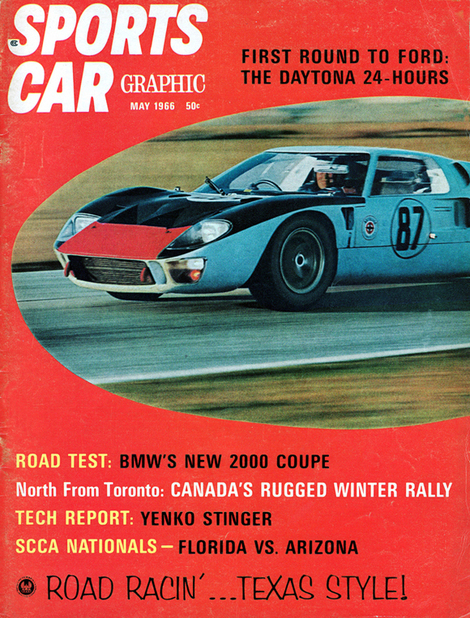
The Ford GT 40, along the Cobra is one of my all time favorite cars in terms of looks performance and handling.
The Ford GT40 was a high performance sports car and winner of the 24 hours of Le Mans four times in a row, from 1966 to 1969. It was built to win long-distance sports car races against Ferrari (who won at Le Mans six times in a row from 1960 to 1965). The car was named the GT (for Grand Tourisme) with the 40 representing its overall height of 40 inches (1.02 m, measured at the windshield) as required by the rules. Large displacement Ford V8 engines (4.7 L and 7 L) were used, compared with the Ferrari V12 which displaced 3.0 L or 4.0 L. Early cars were simply named "Ford GT". The name "GT40" was the name of Ford's project to prepare the cars for the international endurance racing circuit, and the quest to win the 24 Hours of LeMans. The first 12 "prototype" vehicles carried serial numbers GT-101 through GT-112. The "production" began and the subsequent cars, the MkI, MkIIs, MkIIIs, and MkVs, numbered GT40-P-1000 through GT40-P-1145, were officially "GT40s". The name of Ford's project, and the serial numbers dispel the story that "GT40" was "only a nickname."
In this article, John Blunsden writes with a witty sharp satirical style that combines humor with technical information about the car. This approach and attitude seem very 1960's in it's style and humor.
This article is recreated from Sports Car Graphic May 1966
If you're looking for the ultimate in status symbols, a personally-fitted Ford GT 40 for everyday use is it!
by John Blunsden
IN OUR AFFLUENT SOCIETY, THE SEARCH FOR A STAUS SYMBOL. BECOMES DAILY MORE DIFFICULT. A few years ago you could impress neighbors with a set of hi-fi equipment, color television in every bedroom, or a high-speed power boat in the back of the garage. Now, unless you have all these things, you're getting close to the Administration's under-privileged classification, and more important, you'll cut no ice at all with the folks next door!
What's left? Well, you could buy a new bed, and have it delivered nice and slow so that everyone in the street can read the inscription on the headboard, "As used by Elizabeth Taylor and.............?" Or you could install a pint-sized computer in the kitchen and invite all your fat friends in for a computerized diet of low-calorie foods (a hidden electronic brain will photograph and weigh them as they step over the threshold, the news will be fed through the computer, which will supply the appropriate diet). On second thoughts, this will probably win more enemies than friends.
No better go back to that perennial status symbol, the motor car, through with Cadillacs becoming as prolific as Cortinas, and Ferraris as numerous as Fiats (at least that's the way it's beginning to look), it's a nightmare trying to find something to really ring the bell.
And so, a hearty vote of thanks to the Ford Motor Company, through whose offices (especially the one in Slough, Buckinghamshire, England, with 'Ford Advanced Vehicles' on the front door) the status-seeker shall seek and he shall find.
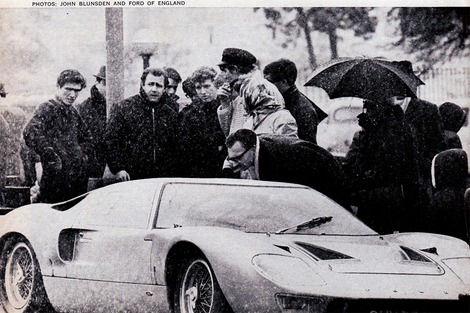
Knock on the door, ask to see John Wyer, and if you happen to have 5,500 pounds in your hand (the equivalent of $15,500 US dollars will do - indeed, in view of Britain's balance-of-payments difficulties, will probably bemore acceptable!) he'll build you a road going version of the car that's twice broken the LeMans' lap record and which, with a bit of luck and a few million dollars, might even win the race there this year. In short, you can become a member of the ultra-exclusive 'GT 40 Set'.
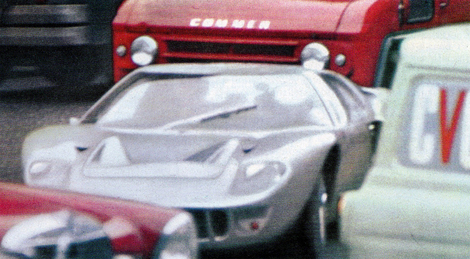
Now, as Mr. Wyer will be anxious to tell you, they don't sell GT 40's to just anyone, in the same way that beatniks are not exactly encouraged in Saville Row. And, just as they have never even heard of the term 'off the racks' in that palace of master tailoring , so, at Slough, they wouldn't dream of issuing you with a GT 40 for which you had not been given a personal fitting. (Don't mention it to your friends, but the reason for this is that, as on all Ford GT's the seats are fixtures, a part of the basic body structure, and variations in leg room are made through adjustable pedals. It's far better for the image if you just casually mention that it was built around you, and leave it at that!)
Another thing it's worth keeping quiet about is the power unit. Don't whatever you do, say it's based on the Ford 289 that close-on half the world seems to be using, with a bit of 'Weber carb tune' to give it 335 bhp at 6,250 rpm. Far better to say that it's the specially developed Ford race engine, very slightly detuned to give it that unfussy boulevard performance which makes the GT 40 such a natural for expeditions to the supermarket. Apart from helping to maintain the image again, it also happens to be Broadley (sorry, I meant broadly!) true.
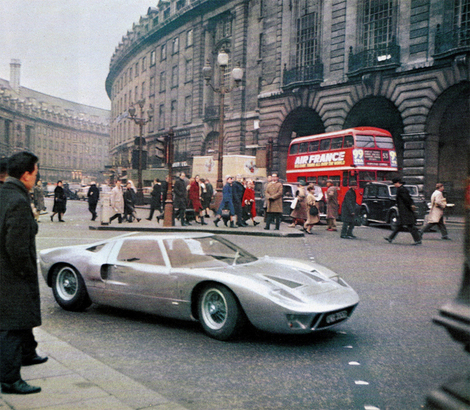
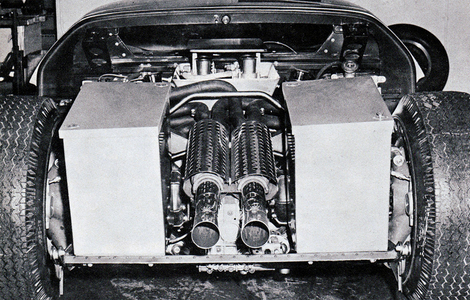
If you find that the neighbors are not to impressed with this detuning business, steer the conversation around to the point where they've just got to ask, "What'll she do?" This is where you say, "We'll, it depends ypon the gear-box and the final-drive ratios." (If you'll accept a spot of advice, you'll take the standard set, even though you can specify a whole load of alternatives. At least you'll then be able to remember exactly what your maxium speeds in gears are, and trot out the telling figures with a carefully rehearsed air of casualness.)

"With the gearing I've chosen as being the most suitable for my own personal needs (ha ha!), it gives me 58 mph in first, 90 mph in second, and 127 mph in third." (Pause for the inevitable, "But what's so marvelus with 127, why I can get nearly....") Then interrupt with "...........with 142 mph in fourth and, just in case I'm really on form ,I've got a fifth gear that'll give me a cool 160 mph before I reach the redline. "Don't whatever you do, admit that you'll likely never be brave enough to get the neddle over 120 or 130, because he's certainly not going to admit that he's never done over 90 in his Caddy, especially now that he's on the defensive! Oh yes, you might as well mention that the transmission's by ZF, and that they also turn out sets of gears for Jim Clark's Lotuses, as well.
Even in a world of the 'bigger the better,' the motor car is becoming the exception, and anything that stands only 40 inches high is impressive, so keep mentioning the height, and the fact that like all good Grand Prix drivers, you drive it lying down. And when the girls chorus, "Lying down?!", you explain away the wide center tunnel which divides the two seats by pointing out that occasionally there are moments in life so precarious that even sex has to take a back seat (of which there is none), and that the GT 40 is the ultimate expression of another type, which can also be highly enjoyable......."Why don't you climb in, and find out?"
The getting-in process, she will find calls for considerable athletic prowess, mainly in the broad jump - no pun intended - and either a pair of slacks or a tight skirt and do-it-yourself instant repair kit. It's all on account of those side side cells, which between them swallow up 31 Imperial gallons of fuel (the very best, of course!), which should be sufficient to let you give her a 400-mile test run. This should give her time to soak up all the 'bull' you give about the equipment. The instruments she'll be able to see for herself, so just mention, as a throw-away line, "Of course, you'll have already noticed that it's got every instrument in the book," and concentrate on some other stuff. But don't make it too obvious -- the subtle way is usually the most effective. Like: "Do make yourself comfortable, Honey and relax on the gentle cushion of air that's flowing through the perforated seat covers, and by all means adjust the outlet of the Aeroflow fresh-air system so that the volume, temperature and direction of the air is entirely to your liking. And if you tire of the view through the electrically heated windshield, by all means glance through the tinted glass of the side and rear windows if you find the color more restful," and all that jazz.
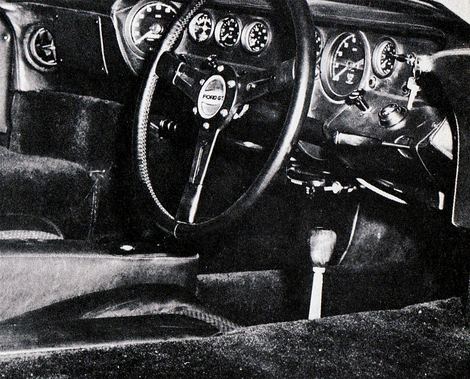
You might also mention that it's the special exhaust that makes it so easy to listen to the radio at high speed. or to converse in such a seductive voice, and that it's the 25-percent reduction in shock stiffness that's making for such a smooth ride.........and the softer break pads. Let her play around with the heater-demister or air conditioning equipment, and tell her that even the egine's cooled by a thermostatically controlled fan (she won't understand, but it sounds good).
Tell her that she looks good against the black decor of the interior, and that your choice of exterior color from the 150 options offered to you, is so obviously 'hers.' By now, if you've been doing your job properly, she'll be in a "Let's get away from it all" mood, and she'll be understanding when you say, with just a hint of apology, that the specially heat-resistant boxes astride the engine will only accommodate two medium-size suitcases, and that you're still awaiting the latest 'U' shaped box, which will carry three,
If she doesn't slide farther down in her seat, and say, "We'll make do with two," turn the car around and head for home. It'll mean that either she's thumbed a lift under false pretenses, or else you've got no right to own a GT 40 in the first place.
As I said, Mr. Wyer and his chums don't sell them to just anyone!
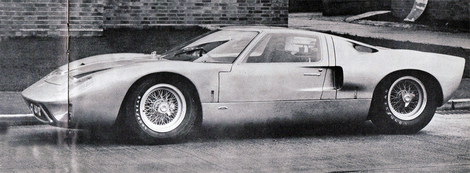
A little more history on the GT 40 and the people who orchestrated this wonderful race car and subsequent versions.
The agreement with Eric Broadley included a one year collaboration between Ford and Broadley and the sale of the two Lola Mk 6 chassis built to Ford. To form the development team, Ford also hired the ex-Aston Martin team manager John Wyer. Ford Motor Co. engineer Roy Lunn was sent to England; he had designed the mid-engined Mustang I concept car powered by a 1.7 L V4. Despite the small engine of the Mustang I, Lunn was the only Dearborn's engineer to have some experience with a mid-engined car.
Broadley, Lunn and Wyer began working on the new car at Lola Factory in Bromley. At the end of 1963 the team moved to Slough, England near Heathrow airport. Ford established a new subsidiary under the direction of Wyer, Ford Advanced Vehicles Ltd to manage the project. The first chassis built by Abbey Panels of Coventry was delivered on March 16, 1963. The first "Ford GT" the GT/101 was unveiled in England on April 1 and soon after exhibited in New York. It was powered by the 4.2 L Fairlane engine with a Colotti transaxle, the same power plant was used by the Lola GT and the single-seater Lotus 29 that came in a highly controversial second at the Indy 500 in 1963. (A DOHC head design was used in later years at Indy. It won in 1965 in the Lotus 38.)
The Ford GT40 was first raced in May 1964 at the Nürburgring 1000 km race where it retired with suspension failure after holding second place early in the event. Three weeks later at the 24 Hours of Le Mans, all three entries retired although the Ginther/Gregory car led the field from the second lap until its first pitstop. February 1965 saw Ken Miles and Lloyd Ruby take a Shelby American entered GT40 to victory in the Daytona 2000 km. The experience gained in 1964 and 1965 allowed the 7-litre Mk II to dominate the 24 Hours of Le Mans race in 1966 with a 1-2-3 result. The finish, however, was clouded in controversy: in the final few hours, the Ford GTs of New Zealanders Bruce McLaren and Chris Amon were running close behind the leading Ford GT driven by Ken Miles. Ford team officials faced a difficult choice. They could allow the drivers to settle the outcome by racing each other -- and risk one or both cars breaking down or crashing. They could dictate a finishing order to the drivers -- guaranteeing that one set of drivers would be extremely unhappy. Or they could arrange a tie, with the McLaren/Amon and Miles/Hulme cars crossing the line side-by-side. The team chose the last and informed McLaren and Miles of the decision just before the two got in their cars for the final stint. Then, not long before the finish, the Automobile Club de l'Ouest (ACO), organizers of the LeMans event, informed Ford that the geographical difference in starting positions would be taken into account at a close finish -- meaning that the McLaren/Amon vehicle, which had started perhaps 60 feet (18 m) behind the Hulme-Miles car, would have covered slightly more ground over the 24 hours and would therefore be the winner. Secondly, Ford officials admitted later, the company's contentious relationship with Miles, its top contract driver, placed executives in a difficult position. They could reward an outstanding driver who had been at times extremely difficult to work with, or they could decide in favour of drivers (McLaren/Amon) with less commitment to the Ford program but who had been easier to deal with. Ford stuck with the orchestrated photo finish but Miles, deeply bitter over this decision after his dedication to the program, issued his own protest by suddenly slowing just yards from the finish and letting McLaren across the line first. Sadly and ironically, Miles died in a testing accident just two months later. Miles was thus denied his deserved unique achievement of winning Sebring, Daytona and Le Mans in the same year, the last before his death.
The Mk IV, a newer design with a Mk II engine but a different chassis and a different body, won the following year (when four Mark IVs, three Mark IIs and three Mark Is raced). After a rule change for 1968 which limited the capacity of prototypes to 3.0 L (the same as in Formula One), but allowed a maximum of 5.0 L capacity for the Sports category (where at least 50 cars had been built), a revised 4.7 L Mk I won the 24 hours of Le Mans race in 1968 against the fragile smaller prototypes. This result added to four other round wins for the GT40 gave Ford victory in the 1968 International Championship for Makes. The GT40's intended 3.0 L replacement, the Ford P68, proved a dismal failure. In 1969, facing more experienced prototypes and the new yet still unreliable 4.5 L flat-12 powered Porsche 917s, the winners Ickx/Oliver managed to beat the remaining 3.0 L Porsche 908 by just a few seconds with the already outdated GT40 (in the very car that had won in 1968). Apart from brake wear in the Porsche and the decision not to change pads so close to the race end, the winning combination was relaxed driving by both GT40 drivers and heroic efforts at the right time by (at that time Le Mans' rookie) Jacky Ickx, who won Le Mans five times more in later years. In 1970, the revised Porsche 917 dominated and the GT40 became obsolete.
Posted 09/29/08 @ 03:36 PM | Tags: Ford GT 40 street version, Ford GT 40, Sports Car Graphic magazine May 1966, GT 40, John Blunsden, John Wyer, Ford Advanced Vehicles Ltd, Eric Broadley, Sports Car Graphic magazine